|
Me Sahyadri |
|
April 2015 |
|
Revised in Jan 2016 |
|
Volume 2, number 4 |
|
Please use minimum 1280 pixel horizontal screen
resolution for viewing. Please be patient while all the images in
webpage are loaded. |
|
Please do not use the images for any commercial
use without permission. Text in Marathi and English is not exact
translation. Special thanks to all those who helped me during the compilation and field work for the help and guidance. The photoessay has been revised thanks to perspective of "Heritage insights" of Saili Palande Datar and Yashodhan Joshi. The location photographed in this journal is in wilderness. The location is habitat of Honey Bees and wild animals. Please do not venture to the location without professional approach and local support. Honeybees are likely to attack the visitors. The knowledge about first aid and preventive care to protect from honeybee attack is essential. |
|
|
|
|
सह्याद्री (पश्चिम घाट) हा एक नैसर्गिक संपदेचा, वैविध्यतेचा, भौगोलिक व ऐतिहासिक ठेवा आहे. वाढत्या मानवी अतिक्रमणाचा, सह्याद्रीच्या विविध घटकांवर होणारा दुष्परिणाम भविष्यात आपल्यालाच धोका निर्माण करेल, यात शंका नाही. शुद्ध पाणी, हवा व उर्जा, भावी पिढीला मिळण्यासाठी, नंद्यांचे उगम असलेला सह्याद्री व त्याभागातील जंगले टिकवणे महत्वाचे आहे. सह्याद्रीच्या महत्वाच्या घटकांचे महत्व छायाचित्रांद्वारे प्रकट करण्याचा मी येथे प्रयत्न केला आहे. येथील पक्षी, प्राणी, वनस्पती, अधिवास, किल्ले व लेणी अशा विविध विषयांबद्दल आपण समजुन घेऊ.
|
|
Western ghats, or Sahyadri as we all call it as, is a treasure trove of spectacular landscapes, biodiversity, flora, fauna, some amazing geological wonders and man made monuments. With the increasing pressure from human encroachment, all these elements are under stress and in turn are under depletion. Western ghats should be left untouched by human beings, to protect their future generations from getting short of resources, such as water, energy and clean air. The important elements of western ghats, which need protection are highlighted in the new version of Photo journal , Me Sahyadri Magazine. The current issue has a brief of inspiring subjects such as birds, mammals, forts, ancient caves, snakes and the ambiance.
|
|
|
| |
  |
| |
| Me Sahyadri – April 2015 - Bhutling Caves
|
| |
|
|
या सदरात, सह्याद्रीच्या विविध घटकांबद्दल छायाचित्र व माहिती द्वारे तोंडओळख मांडली आहे. खालिल चित्रनिबंधात जुन्नर जवळच्या भुतलिंग लेण्याबद्दल छायाचित्रे व मजकुर आहे. या लेण्यात माणसांचा वावर तुरळक आहे. येथे मधमाश्यांची पोळी आहेत. अशा ठिकाणी जाण्यापुर्वी मधमाश्यांपासुन कसा बचाव करायचा व प्राथमिक उपचार (फ़र्स्ट एड) बद्दल माहिती करुन घ्यावी.
जुन्न्नरच्या भोवताली डोंगर आहेत. या डोंगरात प्राचिन बुद्ध हिनायन लेणी आहेत. अंदाजे ५७ विविध ठिकाणी असलेल्या लेण्यांमध्ये महत्वाचे चैत्यगृह आहेत, विहार आहेत. या लेण्यांचा संबंध बुद्ध, हिंदु व जैन धर्मांशी आहे.पुर्व १५० ते इसविसन नंतर १५० वर्षे या कालावधित येथिल लेणी बनविल्या असाव्यात असे मानले जाते. बिटिश लेखकांच्या मते जुन्नर भागात ५७ ठिकाणी लेणी आहेत. जुन्नर भोवताली असलेल्या महत्वाच्या ५ लेणी समुहात, नैऋत्येकडे शिवनेरी, पश्चिमेकडे तुळजा, दक्षिणेस मानमोडी, व उत्तरेकडे लेण्याद्री व सुलेमान लेणी आहेत. या सर्व लेण्यांमध्ये मिळुन १० चैत्यगृह, १७४ विहार, ११६ पाण्याची टाकी व ३६ शिलालेख आहेत. शिवनेरी लेणी येथे ३, लेण्याद्री येथे २, मानमोडी येथे ३, तुळजा येथे १ व गणेश पुर्व येथे १ चैत्यगृह आहेत. शिवनेरी लेणी येथे ७८, लेण्याद्री येथे २८, मानमोडी येथे ४९, तुळजा येथे १२ व गणेश पुर्व येथे ७ विहार आहेत. शिवनेरी लेणी येथे ३, लेण्याद्री येथे ६, मानमोडी येथे २१, शिलालेख आहेत. शिवनेरी लेणी येथे ६०, लेण्याद्री येथे १५, मानमोडी येथे ३८, तुळजा येथे २ व गणेश पुर्व येथे १ पाण्याची टाकी आहेत.
जुन्नर भोवतालची लेणी कार्ले, भाजे, बेडसे, नाशिकजवळच्या पांडव लेण्यांच्या तुलनेने कलेच्या व वैभवाच्या दृष्टीने कमी दर्जाची आहेत. मात्र लेण्यांच्या स्थापत्यशास्त्राच्या दृष्टीने येथील लेणी महत्वाची आहेत. येथील काही लेणी डोंगराच्या गाभ्यातील भेगेमुळे व त्रुटींमुळे अर्धवट कोरलेली आहेत. यामुळे येथे लेण्याच्या कोरिवकामातील वेगवेगळे टप्पे पहावयास मिळतात. प्रदिर्घ काळ येथे लेण्यांचे काम झाले असल्याने वेगवेगळ्या काळातील विविध शैली येथे पहावयास मिळतात. येथील लेण्यांच्या कोरिव कामाचा काळ निश्चित पणे सांगणे कठिण असले तरी अंदाजे इसविसन पुर्व १५० ते इसविसन नंतर ४०० वर्षे या कालावधित येथिल लेणी बनविल्या असाव्यात असे मानले जाते.
जुन्नरच्या दक्षिणेस अंदाजे १.५ कि.मी. अंतरावर, मानमोडी डोंगरावर ३ ठिकाणी लेणी समुह आहेत. या लेणी समुहांची नावे भुतलिंग लेणी, अंबा अंबिका लेणी आणी भीमाशंकर लेणी अशी आहेत.
|
|
This journal introduces you to one of the forgotten Buddhist rock temple through brief information and photographs. As the location is unsafe due to habitat of honeybees, please do not venture to the location without professional approach, and local support. Honeybees attack all the visitors. Honeybee attack can turn fatal.
Junnar is located on the deccan plateau, 20 km east of the main western ghat ridge. The town is surrounded by hills from all the sides. There are mountain forts and old rock cut caves all around the Junnar town. As per British records there are rock cut caves at 57 separate locations. The five prominent caves identified by early British explorers such as James Fergusson, and James Burgess are, Shivneri cliff caves south west of Junnar, Tulaja Leni west of Junnar, Lenyadri leni (Ganesha caves) north of Junnar, East Ganesh hill caves north of Junnar, and the caves of Manmodi hill south of the town. There are total 10 Chaitya halls, 174 vihaars, 116 water tanks and 36 inscriptions in these caves. Shivneri caves have 3, Maanmodi caves have 3, Lenyadri caves have 2 and Tulajaa and Ganesh east caves have 1 each chaityagrihaa (Chaitya hall). Shivneri caves have 78, Maanmodi caves have 49, Lenyadri caves have 28 ,Tulajaa has 12 and Ganesh east caves have 7 vihaaras. Shivneri caves have 3, Maanmodi caves have 21 inscriptions. Shivneri caves have 60, Maanmodi caves have 38, Lenyadri caves have 15,Tulajaa have 2 and Ganesh east caves have 1 water tanks.
Most of the caves of Junnar are with very little ornamental and imagery carvings, in contrast with the caves of Verul and Ajantha. The Dagoba or the Stupaa is common in all the caves. Also none of the Junnar caves are as magnificent as caves of Karle, Bhaje or Nashik. However the group comprises specimens of almost every variety of rock-cut temples, and several forms not found elsewhere. Though the caves of Junaar are plainer than most of those executed afterwards,are still not devoid of ornament. All the caves belong to the first great division of Buddhist caves. The caves have been built between 150 B.C. and 400 A.D. Bhutling caves are said to be made between 100 BC and 100 AD.
Some rock cut caves west of Junaar are located in Maanmodi hill about 1.5 km south from Junnar. There are three groups of caves in Maanmodi hills, viz Bhut leni, Ambika and Bhimashankar. Bhutling leni and Ambika caves are facing north, Bhimashankar caves are facing east.
|
|
|
| |
  |
| |
| The entrance facade of Chaitya Griha, Bhutling caves, near Junnar, Pune district, Western ghats, India
|
| |
|
|
जुन्नर च्या दक्षिणेस मानमोड डोंगराच्या पश्चिमेकडे, भुतलिंग लेणी समुह आहे. येथे एक चैत्य गृह, १५ विहार, १४ पाण्याची टाकी व ३ शिलालेख आहेत. येथील मुख्य चैत्यगृह अपुर्ण आहे. चैत्य गृहाचा दर्शनी भाग कातळात कोरेलेला आहे. या दर्शनी भिंतीवर अद्वितीय सुंदर कोरिव काम आहे. दरवाजाच्या वर मोडलेली खिडकी आहे. या ढासळलेल्या खिडकीवरच्या भिंतीवर नक्षीकाम आहे.
|
|
In Manmodi hills, south of Junnar, there is a group of caves called as Bhutling caves. There is one Chaitya Griha, 15 vihaars, 14 water tanks and 3 inscriptions at Bhutling caves. The main cave at Bhutling caves is an unfinished Chaitya Griha. At the entrance of the Chaitya Griha, there is a rock façade. The façade is very unique and has sculptures on it. It looks like the door had a semi-circular window, which is broken now. The arch of the window is not matched with the arch of the roof inside the Chaitya Griha.
|
|
|
| |
  |
| |
| The entrance facade Torana of Chaitya Griha, Bhutling caves, near Junnar, Pune district, Western ghats, India
|
| |
|
|
चैत्य गृहाच्या दर्शनी भिंतीवर असलेले अर्धवर्तुळाकार तोरणाचे कोरिव काम अप्रतिम आहे. अर्धवर्तुळाकार तोरण ७ पाकळयांमध्ये विभागलेला आहे. मध्यभागी एक अर्धवर्तुळ (पुष्पस्थळ) आहे. आतल्या अर्धवर्तुळाच्या आतल्या भागात एक शिलालेख आहे. मधल्या पाकळीवर अभिषेक लक्ष्मी चे शिल्प आहे. उभ्या असलेल्या लक्ष्मीचा डावा हात कंबरेवर असुन उजवा उंचावलेला हात अभय मुद्रेत आहे. मधल्या पाकळीवर लक्ष्मीच्या एका बाजुस कमळ व एका बाजुस देठासकट कमळपान दाखवलेले आहे. प्रत्येक पाकळीच्या दोन्ही बाजुस कमळाचे फुल कोरलेले आहे. बाजुच्या पाकळ्यांवर पुर्ण उमललेल्या कमळाच्या पुष्पस्थळावर उभे असलेले दोन हत्ती आहेत. हत्तींच्या सोंडेत कलश आहेत. पाकळी वर हत्तींभोवती वर एक कमळ, बाजुस एक कळी, आणी एक देठासकट पान दाखवलेले आहे.
|
|
Over the opening, the façade has a carving which is semi-circular in shape. This semi-circular Torana sculpture is divided in to 7 petal shaped compartments, with semi-circular centre of flower. There is one inscription inside the innermost semicircle.
The central petal has a standing sculpture of Abhishek Lakshmi. Abishek or Gajlakshmi is deity found in Budhism, Jainism and Hinduism. In the petal itself there is a lotus flower and lotus leaf on her either side. Deity has her left hand ib akimbo and right hand is raised and is in abhaya mudra. In flanking two petals there are elephants with sprinklers in their raised trunks. The elephants are standing on the thalamus of the lotus flower.There are lotus flowers over head of these elephants. Apart from the lotus flowers the lotus leaves and buds are also depicted in the sculpture.
|
|
|
| |
 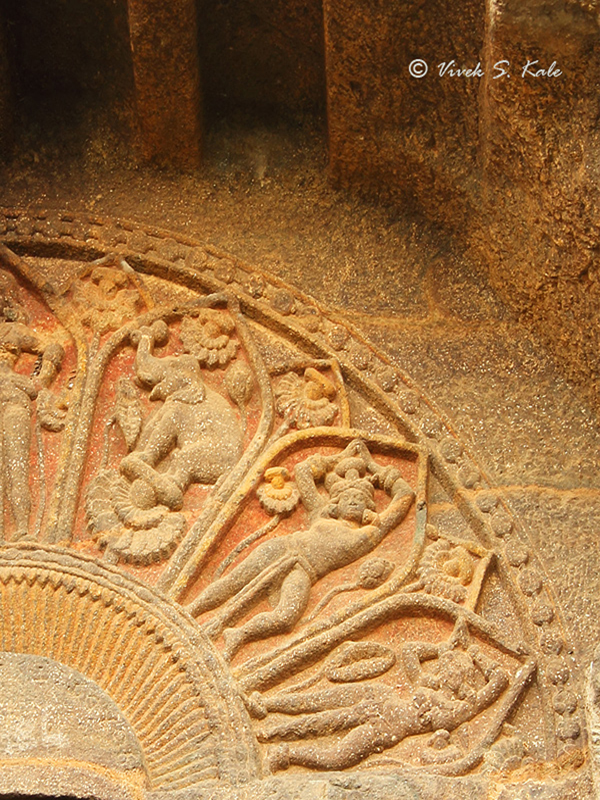
|
| |
| Chaitya Griha facade Torana ornamentation, Bhutling caves, near Junnar, Pune district, Western ghats, India
|
| |
|
|
बाजुच्या पाकळ्यांमध्ये कोरलेल्या हत्तींच्या डोक्यावर सुद्धा कमळाची फुले आहेत. अजुन बाहेरच्या पाकळ्यांमध्ये पुरुष शिल्पे कोरलेली आहेत. त्यांच्या डोक्यावर पागोटे आहे. हातात कडे, व कानात कर्ण अलंकार आहेत. या शिल्पातील पुरुष हात डोक्यावर घेऊन नमस्कार करत आहेत. पाकळी वर एक कमळ, बाजुस एक कळी दाखवलेले आहे.
एकदम बाहेरच्या पाकळ्यांवर स्त्रीया असुन त्या सुद्धा नमस्कार मुद्रेत आहेत. शिल्पात पुसटसा जुना रंग आहे. पाकळी वर एक कमळ, बाजुस एक कमळपान दाखवलेले आहे. या अर्धवर्तुळ तोरण शिल्पात कमळाची फुले, पाने आणी कळ्या कोरलेल्या आहेत. या सात पाकळ्यांच्या मध्ये मागच्या ८ पाकळ्यांची टोके आहेत. यातील सर्वात बाहेरची टोके अर्धी आहेत. या आठ पाकळ्यांमध्ये कमळाची फुले कोरलेली आहेत. संपुर्ण तोरण शिल्पाच्या बाहेर मण्यांची अर्धवर्तुळाकार माळ आहे.
येथे असलेला शिलालेख :
य़वनस चंदानं देयधम गभदा
म्हणजे
“य़वन चंदा कडुन चैत्यगृहासाठी दान.”
|
|
In the outer compartments of the compartments in which the elephants are carved, there are male divotee figures with head turban, bracelets and ear ornaments. The male have their hands clapsed above the head in adulation. In the outermost compartments there are female divotee figures. Within the petal there is a lotus flower and lotus bud alongsides of male devotees. The female have their hands clapsed above the head in adulation. Within the petal there is a lotus flower and lotus leaves along sides of female devotees. The Torana sculpture is almost symmetrical except some finer details of lotus buds, leaves etc. The Torana sculpture has some traces of colours, such as light red and yellow. Behind the seven petals there eight petal heads. There petal heads contain the lotus each. The outer petal heads are partial.
The inscription is
य़वनस चंदानं देयधम गभदा
meaning
“The meritorius gift of the façade of a hall by the Yavana Chanda”
|
|
|
| |
  |
| |
| Stupa, Chaitya Griha, Bhutling caves, near Junnar, Pune district, Western ghats, India
|
| |
|
|
चैत्य गृहाच्या आतमध्ये एक स्तुप आहे. स्तुपावर कोरीव नक्षीकाम नाही आणी हर्मिका नाही. चैत्यगृहाच्या आत एका बाजुस अष्ट्कोनी खांब कोरलेले आहेत. दुसऱ्या बाजुस खांबांचे काम अर्धवट सोडलेले आहे. चैत्यगृहात असलेल्या भेगेमुळे व त्यातुन होणाऱ्या पाण्याच्या गळतीमुळे खोद्काम अर्धवट सोडलेले आहे.
|
|
Inside the Chaitya Griha there is a unfinished stupa without capital. On one side the octagonal columns have been carved out, while on the other side the column carving is unfinished. The interior is unfinished. There is a crack in the rock, which is probable reason for the unfinished state.
|
|
|
| |
  |
| |
| Stupa, Chaitya Griha, Bhutling caves, near Junnar, Pune district, Western ghats, India
|
| |
|
|
| |
  |
| |
| Chaitya Griha Facade sculptures of Garuda and Naga , Bhutling caves, near Junnar, Pune district, Western ghats, India
|
| |
|
|
चैत्यगृहाच्या दर्शनी भिंतीवर दोन मोठे स्तुप कोरलेले असुन त्याच्या बाजुस कमानीच्या दोन्ही बाजुस पुरुष शिल्पे आहेत. एकाला पंख असुन त्याच्या डोक्यावर पागोटे आहे. हे शिल्प गरुडाचे प्रतिक आहे. दुसऱ्या पुरुष शिल्पाच्या खांद्यांमागे दोन्ही बाजुस नागशिल्पे आहेत. हे शिल्प नागाचे प्रतिक आहे. गरुड व नागाच्या एक एक हातात चौऱ्या आहेत. भिंतीच्या एका कोपऱ्यात बोधीवृक्ष असुन त्यावर छत्र कोरलेले आहे. या भिंतीचा काही भाग कोरलेला नाही.
|
|
At the top on façade there are two stupas on either sides. The stupas have rock cut umbrellas on capital of Stupas. In the middle at top there is male figure with turban on either side. One of the men have two snake heads each on either shoulders. The other man has wings on his shoulder with some animal face on top of his turbon. On the right of the arch there is a Bodhi tree with a carved umbrella above it. Part of façade is marked and not carved.
|
|
|
| |
  |
| |
| Cell facade, Bhutling caves, near Junnar, Pune district, Western ghats, India
|
| |
|
|
| |
  |
| |
| Cell facade ornamentation (Srivatsa symbol and flower of life patterned ornamentation), Bhutling caves, near Junnar, Pune district, Western ghats, India
|
| |
|
|
मुख्य चैत्य्गृहाच्या पुर्वेकडे काही विहार आहेत. विहारांच्या दर्शनी भिंतींवर सुंदर कोरीव काम आहे. दरवाज्यांवर असलेल्या चैत्य मखरींमध्ये फुले, श्रीवत्स चिन्ह, धर्मचक्र, तीन सिंह चिन्हे कोरलेली आहेत. दोन मखरींमधल्या भागात स्तुप कोरलेले आहेत. पुर्वकडे व चैत्य गृहाच्या पश्चिमेस काही विहार आहेत. पुर्वेकडे पाण्याची टाकी आहेत.
|
|
On the east of the main Chaitya Griha, there are four cells with neatly carved facades. Each door of cells has Chaitya window arch over it. Between the archs there are stupas with umbrellas carved in rock. There are smaller archs and rail pattern at the top. There are symbols in the chaitya windows on the façade.The symbols such as Srivatsa, ribbons with knots, flowers, Dharmachakra, three lions.There are more cells on left and towards the top. There are more cells on the west of Chaitya Griha. The water tanks here on the left of the main chaitya are interesting, and some of them are covered.
|
|
|
| |
 
|
| |
| Cell facade ornamentation (Srivatsa, Triratna symbols and Dhammachakra patterned ornamentation), Bhutling caves, near Junnar, Pune district, Western ghats, India
|
| |
|
|
| |
 
|
| |
| Cell facade ornamentation, Bhutling caves, near Junnar, Pune district, Western ghats, India
|
| |
|
|
| |
 
|
| |
| Cell facade ornamentation, Bhutling caves, near Junnar, Pune district, Western ghats, India
|
| |
|
|
| |
 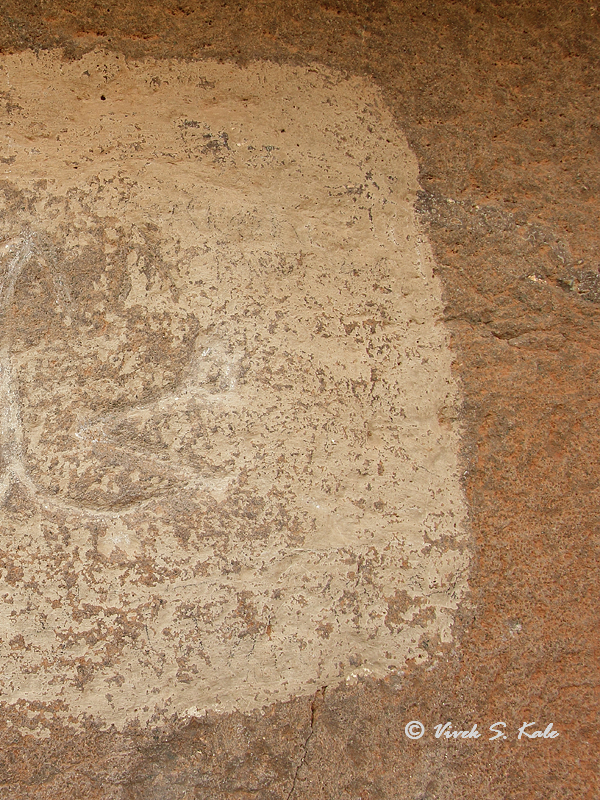
|
| |
| Arabic inscription, Bhutling caves, near Junnar, Pune district, Western ghats, India
|
| |
|
|
| |
 
|
| |
| Vihaar, Bhutling caves, near Junnar, Pune district, Western ghats, India
|
| |
|
|
| |
 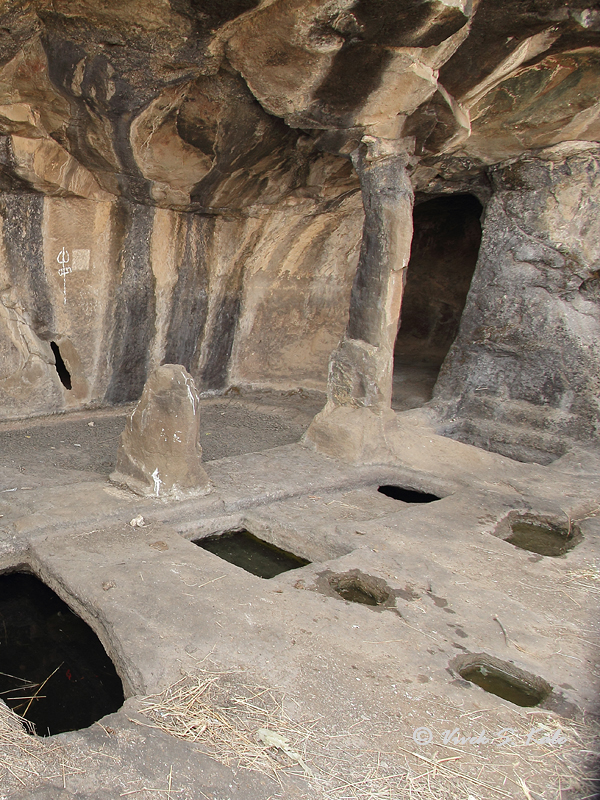
|
| |
| Vihaar with interconnected underground water cisterns, Bhutling caves, near Junnar, Pune district, Western ghats, India
|
| |
|
|
| |
 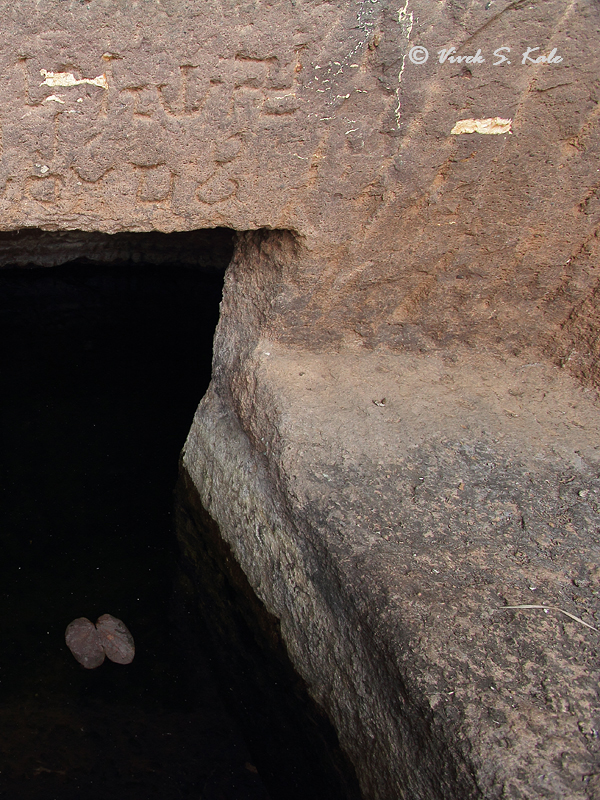
|
| |
| Inscription at the water cistern, Bhutling caves, near Junnar, Pune district, Western ghats, India
|
| |
|
|
शिलालेखाचे वाचन (ब्राह्मी लिपी, प्राकृत भाषा):
"कुमिय सुलसा मातुय पोढि देयधंम"
मराठीत भाषांतर :
"सुलसाची आई कुमिय हिची पाण्याच्या टाक्याची पुण्यकारक देणगी"
|
|
The inscription is in Prakrit language written in Brahmi script :
"कुमिय सुलसा मातुय पोढि देयधंम"
The inscription means : "The meritorious gift of water cistern by Sulasa's mother Kumiya"
|
|
|
| |
 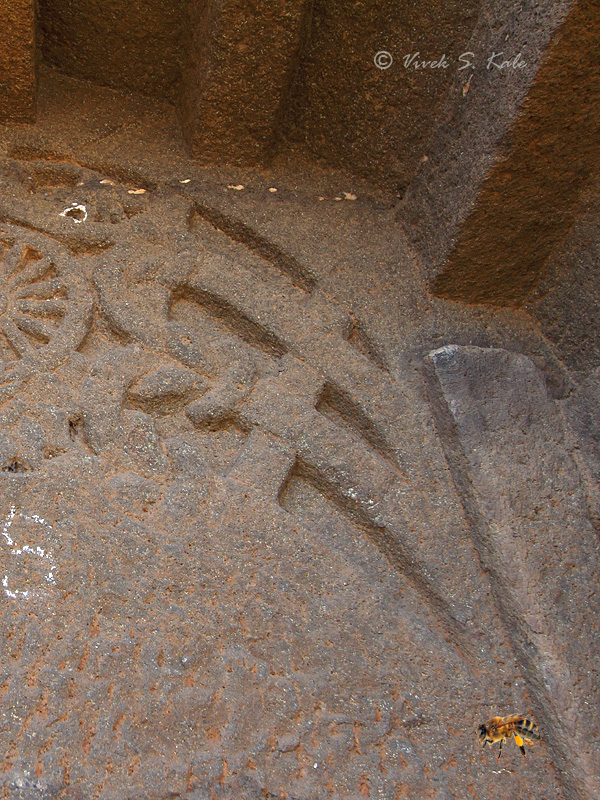
|
| |
| Cell facade ornamentation, Bhutling caves, near Junnar, Pune district, Western ghats, India
|
| |
|
|
| |
 
|
| |
| Cell facade ornamentation, Bhutling caves, near Junnar, Pune district, Western ghats, India
|
| |
|
|
| |

|
| |
| Bodhi tree on facade of main chaitya griha, Bhutling caves, near Junnar, Pune district, Western ghats, India
|
| |
|
|
| |
 |
| |
| Sketch based on photograph from British Records.
|
| |
|
|
| |
|







































